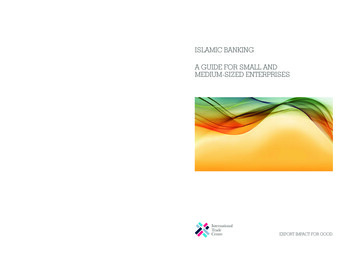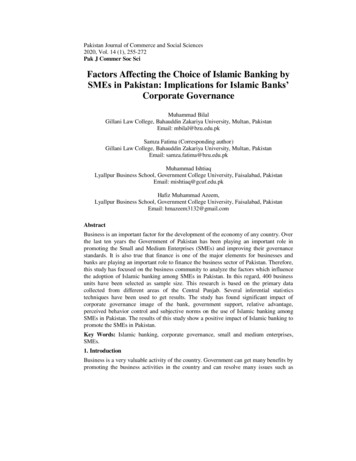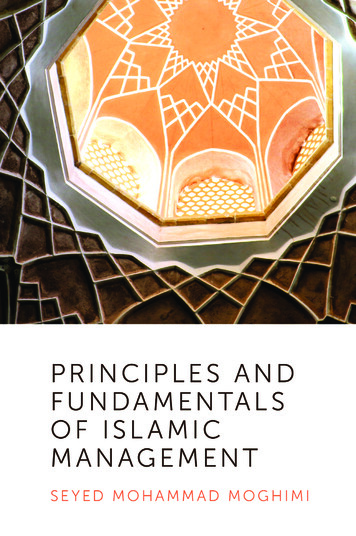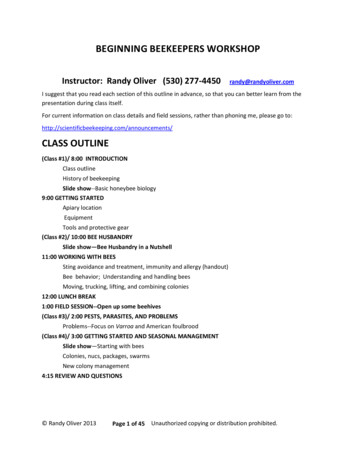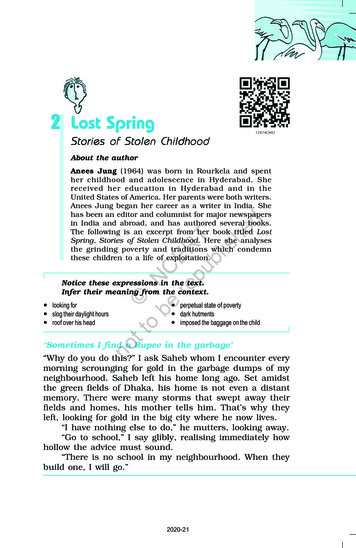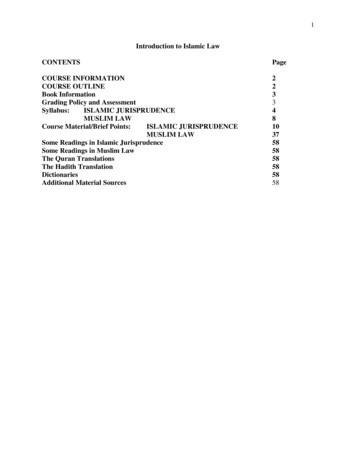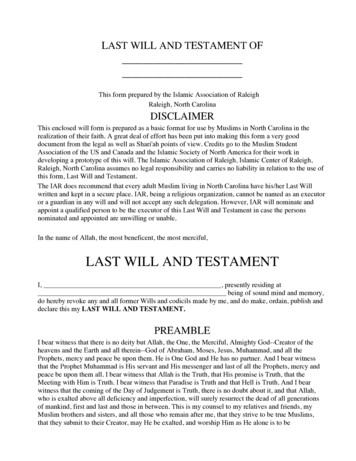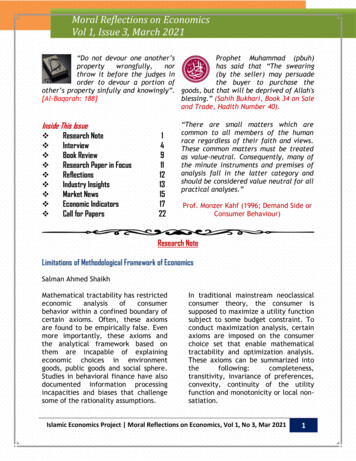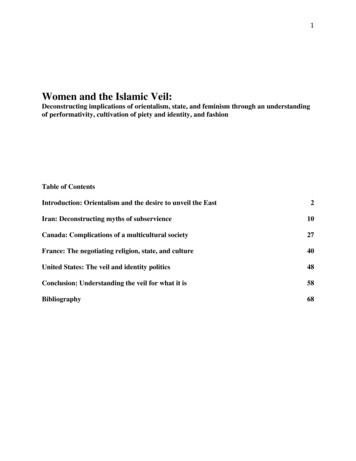
Transcription
1Women and the Islamic Veil:Deconstructing implications of orientalism, state, and feminism through an understandingof performativity, cultivation of piety and identity, and fashionTable of ContentsIntroduction: Orientalism and the desire to unveil the East2Iran: Deconstructing myths of subservience10Canada: Complications of a multicultural society27France: The negotiating religion, state, and culture40United States: The veil and identity politics48Conclusion: Understanding the veil for what it is58Bibliography68
2Introduction: Orientalism and the desire to unveil to EastSince 9/11 Western media sources have developed a visual shorthand for representingIslam. The most common stereotype is that of the veiled woman, a figure that ambivalentlystraddles both ideals of multicultural inclusivity and the threat of radicalization as contextdemands. In this usage of the veiled woman as a loaded symbol, western media are continuing anOrientalist history in its representation of Islam, such that Muslim women’s’ voices are stillbeing silenced. In this paper, I hope to break this stereotype apart by highlighting the diversepolitical and cultural contexts in which Muslim women think about the veil, such that the imageof the anonymous veiled woman can no longer be read as shorthand for Islam.It is important to state at the outset that the Quran does not thoroughly prescribe howwomen ought to dress. In one passage, direction is given to observe certain modesties but what isparticularly noticeable about this passage is that it is addressed to both men and women.Tell the believing men to lower their gaze and be modest. That is purer for them.Lo! Allah is aware of what they do. And tell the believing women to lower theirgaze and be modest, and to display of their adornment only that which is apparent,and to draw their veils over their bosoms, and not to reveal their adornment saveto their own husbands or fathers or husbands' fathers, or their sons or theirhusbands' sons, or their brothers or their brothers' sons or sisters' sons, or theirwomen, or their slaves, or male attendants who lack vigour [sic], or children whoknow naught of women's nakedness. And let them not stamp their feet so as toreveal what they hide of their adornment. And turn unto Allah together, Obelievers, in order that ye may succeed. (Quran 24:30-31)Despite how little the holy book states on the subject of veiling, the woman’s veil has drawnpeople's attention throughout history and is still widely debated today. The veil or head coveringcomes in many forms, and individuals from both within and outside the religion have interpretedit in many ways. The culturally diverse practices of veiling lend specific meaning to both how awoman’s dress is read by her immediate community (identification) but also to how a womanchooses to dress (identity). A woman may wear a simple covering of the head with a colorful,
3black, or sheer cloth known as a hijab. In western countries, the hijab is the main veil that isworn whereas in Iran the chador is prescribed by law under the Islamic Republic. In Afghanistan,particularly under the Taliban, a woman may wear a full face, head, and body covering called theburqa. In Saudi Arabia, a woman commonly will wear a covering with a veil across the face,revealing only her eyes. This is called the niqab. (Petersen). Despite this cultural variance ofveiling, and despite diverse interpretations of veiling (whether spiritual, cultural or political),women’s covering in general has in western media often been reduced to symbolize theperceived “wrongs of Islam.” Even though Muslim men also follow a dress code, it is women’sveiling that has been the subject of contested debate (Awadalla). Where the Arab man's dresssignifies an oppressor or seducer, the women's dress is read as a symbol of the oppressed. Byfocusing on women’s oppression, the West legitimizes its “war on terror” as one bringingliberation to Muslim women (See Chapter 3).To fully understand how the veil as symbol has come to be loaded with negativeconnotations in the West, it is necessary to briefly chart the history of Orientalist representation.The scholar Edward Said, from Columbia University, used the term Orientalism to denote theconstructed lens through which the West sought to know (and thereby dominate) the East. Priorto Said’s influential book (1978), Orientalism referred to a painterly movement in which the Eastwas romanticized by Euro-American artists of the eighteenth and nineteenth centuries. Said’swork shows how the West consistently produced an image of the East as its inverse: where theWest was enlightened, the Orient was barbaric; where the West was civilized, the Orient wasprimitive; where the West was rational, the East was beset by passion. This constructed view or“othering” of the Orient was then used to justify the West’s imperial conquest of North Africa,the Middle East and Asia. This Orientalist lens is still evident today in popular discourse in that
4people of the East are seen as different and more dangerous than the people of the West.Orientalism then is not assigned to the past, but continues today in people’s preconceived notionsabout people from the Arab world and what it means to be Muslim.According to Said, a defining moment in Orientalism was Napoleon’s conquest of Egypt.This moment is important to recognize because it created the common notion that the Orient wasboth different and inferior to the West. When he conquered Egypt, he not only brought in themassive fighting armies, but an army of scientists. These scientists were employed to documenthow the Arabs functioned for European understanding, indicating that they were not consideredthe same as people of the West. The underlying power structure implemented by the Westcreated a dynamic where the West was seen to be “discovering” the Arab country. The Arabsbecame something foreign, examined as a new species and to be experimented with. Thuswestern colonialisation was an ideological conquest as well as the imperial one.The lens through which the West views the veil today can be traced back to nineteenthcentury orientalism. Within Orientalist representations, the veil conjures both eroticism andoppression. When countries were first colonized, the Arabian orient was seen as mysterious andalluring, and this was translated by the image of the mysterious yet alluring veiled women(Yegenoglu 39). The veil was understood as a device that kept women apart from men (likepurdah and harem), but the desire to penetrate this secretive space of women became a commoncolonial fantasy, mirroring the larger colonial project to take control of land and resources. Thesight of the veiled women evoked erotic fantasies by Western males and drew on their desire fordomination. While the seclusion of the women from the public sphere created in the colonizer’smind an erotic invitation, this desire was entangled with the idea of freeing these women fromtheir backward culture.
5The reading of the veil as a symbol of oppression originated in writings that depictedMuslim culture as inferior and backwards. Between 1800 and 1950, an estimated 60,000 bookswere produced about the Arab orient in the West (Hoodfar 8). The purpose of these books was toshow colonized Muslims as underdeveloped and in desperate need of “help” from the West.These writings depicted Muslim women as imprisoned by barbaric Arab males, trapped inpolygamous marriages, or forced to cover their bodies with the veil (Hoodfar 8). This reading ofthe veil as a symbol of oppression served to show how Muslim women were entrapped by aviolent patriarchy, and their only way out was through the help and intervention of the West. Thecolonizers not only thought they were the ones that could save the women, but also believed thatthey could take over societies through the conquering of women (Yegenoglu 40). Women in thissense become the key to owning the society.To understand more fully thismovement between desire andcontrol, it may be helpful to look toexamine a particular example ofcolonial representation of orientalwomen. During the French colonialrule of Algeria, a series of postcardsdepicting Algerian women in an erotic light were printed to send home (Betts 527). Thesepostcards allude to the deeper subconscious force of orientalism.Representations of the political dynamics of colonialism surround these postcards. Thephotographer’s project is representative of the colonizers’, and the female can be read as ametaphor of the terrain to be surveyed and colonized. The woman is sexualized through the
6photograph, becoming someone who is waiting to be seen (Betts 529). The woman is made to beseen as inviting the Western man to ravish her. This is often affected using the veil that bothconceals and reveals the woman’s body, eroticizing and fetishizing her cultural difference.These postcards helped to popularize a stereotype of the Oriental woman, and the societyfrom which they came. It is important to recognize that theseimages were fabricated and not documentary evidence: thephotos were not taken by a journalist going into harems andphotographing Algerian women. Rather, these photos weretaken in a studio with hired models (Awadalla). Therefore,the lens on the camera may be said to be the same as theOrientalist lens mentioned earlier. These images were put onpostcards and mass-produced, giving Westerners theimpression that they had the power to look in on the womenCairoPostcardTrust.of the Orient and claim them.When colonized countries sought their freedom from colonial rule, the colonizer’sromance soured and the veil came to be interpreted less as an invitation and more as a symbol ofoppression and/or rejection of Western values. Since the countries were no longer places ofmystery, neither was the veil. “The post-colonial imagery has been far less concerned withunveiling than with maximizing the social, cultural and political distance between the 'West' and'Islam' and conveying a sense of threat through an inversion which emphasizes the mostcomplete forms of female covering, a hyperveiling” (Toni 121).The veil became a way to differentiate the West from Islam. Whereas in postcolonialdiscourse the veil was taken up as a visual marker of resisting Western imperialism, in
7neocolonial discourse the veil once again became the marker of the backwardness of the East,and was coupled again by the desire for its removal. However, this time the desire to unveil wasnot erotically charged desire. Instead, neocolonial discourse equates women’s liberation with aripping off the veil. Problematically, though, for many Muslim women the veil provides the verymeans to being freed from being cast as a sexual object.This is where the argument of choice has become an important topic within discussionsof the veil (Awadalla). Freedom of choice and religion are often the loudest proclamations madewithin Western society. Yet, when discussing the veil, it is a common, almost naturalized,reaction, for Westerners toassume a woman wearing theveil is being forced to do so. Itis this reaction that enacts whatwe can call a modernorientalism. “Orientalism is aFaithFreedom.orgway of thinking that assumesthere is an absolute differencebetween East and West. According to this logic, the West is seen as rational, developed, human,and superior. In contrast to the East, which is defined as it’s opposite, irrational, underdeveloped,barbaric and inferior.” (Professor Alsutany)One of the strongest examples of contemporary orientalism can be seen in mediaportrayals of Islam. After 9/11, Muslims were stereotyped as threatening terrorists, but thisstereotype was not new to 2001 but rather reborn. Media coverage of Iran’s Islamic Revolutionhad already planted this stereotype of the violent Muslim aggressor in modern America. The
8power of this stereotype is such that the photograph above of veiled women with blank faces andmachine guns would lead many Americans to think that these women are militant radicals. Yet,this picture is actually of the Iranian police force, which has recently allowed women to join theirranks, and thereby would be more accurately interpreted as a depiction of women gaining statuswithin their society.Given the orientalist reading of the veil, it has become“commonsense” in the west that veiled women are oppressed(Hoodfar 8). When political conflicts between the Western andIslamic world erupt, the images that start to appear of Muslimwomen are fabricated to bring forth maximum emotionalreaction from the common person (Lewis). Often, these are ofanonymous, veiled women who are denied cultural and/or geographic or even domestic context.They are represented as dark phantoms or sinister totems, silently encroaching upon secularsociety. For example, during the headscarf controversy in France, the images that were presentedalongside news articles would show a woman in a full chador actually located in Iran. Thisimage is the most dramatized image of a Muslim woman, and is perceived to be most threateningto the French Republic (Lewis). Meanwhile, the woman pictured is not even from France, wherein fact the majority of Muslim women wear the hijab rather than chador or niqab.In this way, orientalism is strategically used as a lens through which the media seek toinvoke certain emotions, especially when there is a political crisis. The following chapters willfurther demonstrate how the image of the veiled woman is repeatedly used within media tosignify a threat and/or obstacle to liberal democracy even though local attitudes to veiling in Iran,France, USA, and Canada vary greatly. The chapters on each country will examine coverage of
9recent events that have generated widespread debate both nationally and internationally, andthereby draw attention to the complexity and diversity of issues that a woman’s right to veiltouch upon (i.e. human rights in Iran, secularism in France, multiculturalism in Canada, andidentity politics in USA). It is hoped that by examining the complexity that the image of theveiled woman will no longer go unquestioned as a symbol of oppression.Through the decompression of the meanings that have been overloaded onto the veil, adeeper understanding of the veil may be reached. Through acknowledging the colonial readingsof the veil and charting the different political agendas in representations of the veil, this paperseeks to show that these imposed readings often have little bearing on Muslim women’s personalchoice to wear the veil which for many is often as much an item of fashion as it is of faith. In sodoing this paper seeks to score, what Emma Tarlo has called “the polyphonic resonance” of theveil (2010).
10Iran: Deconstructing myths of subservienceIran currently is governed under Shi’a Islamic Law, where wearing the veil is mandatory.Since the veil is something that is mandated, it functions very differently there than it does inWestern countries. This major difference in functionality of the veil also translates to how it isseen by the West. Indeed many western commentators reacted to the Islamic Revolution of 1979as a regression into pre-modernity, and the veil became a symbol of this shutting out of themodern world.The media portrayal of Iran has been influential in how the West has come to see andunderstand women in Iran. The images and news stories that have been plastered throughoutrecent history depict the veil as oppressive, and in many cases Islamic law as barbaric. However,the strict (and often harsh) enforcement in recent years of compulsory veiling makes for a strongargument of this depiction. However, the assumption is that should the requirement to veil belifted that all Iranian women would stop wearing the veil. This is an equally misguidedimposition, for again it sidelines Muslim women’s voices and the variety of positions thesewomen occupy in relation to the veil.Since 2007, under President Ahmadinejad, there has been a noticeable increase in therestrictions of women’s rights. The article on Iran published by FreedomHouse.org, anindependent organization committed to the global expansion of freedom, explains the loss ofcivil liberties that have largely affected women. For example, in 2012, women were barred fromregistering in 77 fields of study at 36 universities. Despite this limitation, however, women makeup the majority of university students. Yet, only three women currently sit in parliament, andthey have been continuously excluded from running for higher office. Female judges do not havethe authority to issue final verdicts. Moreover, women cannot attain a passport without the
11permission of her husband or a male relative. In court, a women’s testimony only carries half theweight of a male’s, as is the case with compensation for a death in that a women receives halfwhat a man would.Women have also seen the Islamic dress code become much stricter under PresidentAhmadinejad. Every spring it was usual to see a slight strict enforcing of the dress code becauseof the warm weather, people become lax in the way they dress. However, in the spring of 2009,President Ahmadinejad launched the toughest crackdown that the country had seen in nearly twodecades (Conroy). The dress code under Ahmadinejad’s predecessor, President Khatami, hadbecome more relaxed with women choosing headscarves that were tied more loosely (henceshowing their hair) and fitted jackets that may have only reached to their knees rather than theirankles. The crackdown, in major cities like Tehran, caused 278 women to be detained, 231 ofwhom were released after signing documents that they would not violate the dress code; another3,548 women received warnings about their dress and “Islamic guidance” (Conroy).This issue of women’s dress arose again in 2011. This time, however, it was more of anissue between the President and Shiite clerics. Ahmadinejad wanting to take a culturaleducational route involving the dress code. This approach would educate women on the benefitsof wearing the hijab, and would lead them to decide to cover themselves on their own. Shiitecleric, Ahmad Khatami, strongly disagreed with this approach, he said, “Blood should be shed tosolve this issue and eradicate this problem from the society” (Erdbrink). This caused an increasein the enforcement of the dress code. Impounding cars driven by women without headscarves,fining women, and punishing them, which included whipping (Erdbrink).Despite all of these restrictions, women still play an active role in Iranian society. Theselaws attempt to control and define the role that women can play. However, this does not mean
12that the women are passive or subservient. On the contrary, because of these laws, some womenhave become more active in the fight for women’s rights and the ability to hold higher positions.Examining two women, who are iconic for their political opposition, shows the ability of theIranian women to work against the restrictions the government has set for them.Most famously, Shirin Ebadi received the Nobel Peace Prize in 2003 for her worktowards the promotion of human rights. Shirin Ebadi was the first female judge in Iran, but afterthe Revolution (1979) she was demoted to a legal assistant (Shapiro). She then started her ownlaw firm that mainly focused on the rights of women and children. She also fought many casesagainst the government, some of which ended with her going to jail and being fined.When Ebadi travelled to Stockholm to receive the Nobel Peace Prize, she chose not toveil. She said, "Inside Iran, a woman is required by law to wear the hijab so I wear it. However,as I mentioned, I believe that with a more progressive interpretation of Islam we can change this.I believe that it is up to individual women to decide whether they want to wear the hijab or not"(CAPRA). In the speech, and interviews she gave, when receiving the reward, she spoke abouthow Islam as a religion is not the violator of human rights; it is, rather, the government’sinterpretation of the religion. For example the laws that quantify value of a woman’s life as halfthat of a man’s has no Quranic justification, but is an interpretation made by clerics it states: thetestimony of a women is worth half that of a man, and compensation of women’s death is half ofwhat a man’s would be (Bakker). Ebadi argues that it is only through women’s ownunderstanding and interpretation of Islamic law that they can understand what is right and wrongfor them.Ebadi choosing to not wear the headscarf when receiving the award was thought to bedeclaring a position for women to unveil, even though she said that it was not. Multiple news
13programs asked questions about it, probing the meaning behind it, only to get the response thatshe believed it is an individual choice for someone to veil or not (CAPRA). (Other mediareactions to her being awarded were surprise in that she was relatively unknown, particularlywhen other nominees included Pope John Paul II (CNN 1). However, there also seemed to be atone of general optimism, that since the award had been presented to Ebadi, it would helppromote women’s and human rights within Iran (CAPRA).The Iranian government’s reaction to Ebadi versus the people of Iran’s was extremelydifferent. The government barely acknowledged the award, and even came to confiscate it fromher years later, demanding 410,000 in taxes and freezing her accounts (BCC News). Accordingto secondary sources, the local newspapers were filled with slander against Ebadi. Thesenewspapers are controlled by the government, and directly related to the interest of the thenPresident Khatami, who acted as a public endorser of what the newspapers published(Azarmehr). When Ebadi landed in Iran, some members of the Parliament were there to greether, except Khatami. In fact, Khatami was quoted saying, “The Nobel Peace Prize is not thatimportant. The ones that count are the scientific and literary prizes” (Fathi). Even though womenfaired better under the reign of President Khatami, the incident with Edabi shows that he was notgoing to be in full support of women gaining complete rights.Most of the Iranian public had a very different opinion about Ebadi’s award, especiallyIranian women. Fathi, writing for the New York Times, quoted one of thousands of women andsupporters who came to greet Ebadi at the airport on her return from Sweden: “'She has becomea reason for me as a woman to feel empowered, especially after I saw her on satellite TV in Pariswithout her head scarf. It takes a lot of courage to do what she did, and I admire her for that.”The people there to greet her were chanting “Khatami, shame on you” and “Freedom of thought
14is not possible with Khatami” (Fathi). Along with the chants of encouragement for Ebadi, theyalso chased away hardline vigilante group members who were there to protest Ebadi (Fathi).The Western media places a much greater focus on the veil and the role it plays forIranian women than the Iranian media. Most media outlets that interviewed Ebadi questioned heron some level about the veil, and showed the positive reaction from the public in support of herdecision not to veil when receiving the reward. Yet Ebadi tries not to focus on the issue of theveil, nor develop a categorical position on veiling other than to say that it should be left to awoman's choice. Arguably, the Western media focused more on her unveiling than heraccomplishments which had lead her to receive the Nobel Peace Prize. In this way, she wasdenuded of both her Iranian identity and her political activism. In contrast, Iranian media wasslanderous, focusing on the fact that as a woman she was not worthy to win. To them, veil or noveil, she should not have gotten the award.Another woman that became an icon the world over was Neda Agha-Soltan, a 26-yearold woman. A film recording her death during the political protests in 2009 was posted onlineand went viral. Neda’s death was to become an icon of the sheer brutality of the Iranian regime.Neda had joined the protests after theJune 2009 elections. The country hadalready been making world news,given that the race for the presidencybetween Ahmadinejad and thecompetitor Mousavi appeared like it would be a close fight (BBC Documentary).When the results came through, Ahmadinejad was re-elected into office by a landslide.The opposition claimed that the numbers presented by the ministry had been falsified. This
15caused public outrage and protest. Neda was one of thousands that took to the streets in protest.In the BBC Documentary, Neda: An Iranian Martyr, one of the women interviewed said thepolice and the Basijs (militia) were very violent and a lot of the violence was directed at women.The day before Neda’s death, at Friday afternoon prayer, on a national televisionbroadcast, Ayatollah Ali Khameneithreatened to use force on theprotesters (Tait). This was a warning tothe protesters that the militia hadpermission to open fire on them. Yetmore people chose to protest that daythan any other, and Neda went along with her music teacher. When she decided that it was toodangerous and was going to go home, and when she was only 26 feet from her car, Neda wasshot in the chest (BBC Documentary). The man who shot her was a Basij; the protesters grabbed,beat, and then released the killer. This whole event was filmed with a cell phone, which was putonto youTube.com, and went viral on every news station around the world. Neda was the first ofthirteen to be killed that day. A voice yelling out “Neda” could be made out on the video. Withthis, her name and image became the icon of the opposition of the Iranian government (BBCDocumentary).There is a major difference in how Western media handled this event and how it washandled within Iran’s media. Western media spread the video, images, and story of Neda as fastas they could, in many cases before the full story was even known. Neda was characterized inmost stories, like the one presented by Los Angeles Times' Borzou Daragahi, as someone whowas politically active “but she was never an activist” and “she began attending the mass protest
16only because she was outraged by the election results” (Daragahi). President Obama made astatement about the event saying, “‘It’s heartbreaking And I think anyone who sees it knowsthere is something fundamentally unjust about it’” (CNN 2). Through promoting the story ofNeda, and the injustice that happened, Western media made her into an icon for the peopleprotesting the government.The Iranian government did not promote coverage of this event, nor of any event relatingto the protests in general. All foreign journalists were told to leave the country because thegovernment could not guarantee their safety. When one independent journalist did not leave, hewas put into jail for espionage (BBC Documentary). This caused cell phone videos to becomethe opposition’s way of showing the outside world what was happening. When the video of Nedahad global viewership, the government made every attempt possible to discredit it, calling it aconspiracy. The family and boyfriend of Neda were told not to speak to anyone about what hadhappened, were not allowed to hold a wake, or put up notice about her death (BBCDocumentary). Her boyfriend, Caspian Makan, disobeyed the order of the government and spokeout to reporters for CNN. For this, he was arrested, and had four counts of death put against himand was told he would be executed (BBC Documentary). At the Friday afternoon prayer service,on June 26, Ahmad Khatami the senior cleric stated Western media was twisting the event, andthat it was obvious other protesters killed the girl (BBC Documentary).“Their [Iranian government] first reaction was that she was alive. Then they said thefootage was fake. One day they said a BBC reporter killed her. Then they said it was the CIA.Then they said the [Mujahedin] Khalq Organization [MKO] was behind it. The latest is thedocumentary” said Hejazi, the doctor who tried to save Neda after she was shot. Thedocumentary he references was filmed by the Iranian state television. Radio Free Europe / Radio
17Liberty’s Gonlnaz Esfandiari, described the documentary since it is no longer available online. Inhis retelling of the state’s version of events, Neda is a foreign agent who becomes a victim offoreigners and opposition supporters. She pours blood on her own face from a hidden bottle,pretending to be injured. On the way to the hospital, Neda tries to escape and is killed by themusic teacher and the doctor.The Western media’s focus on the personal biography of Neda and her unjust killing atthe hands of government militia presents the case as a human rights issue, one that is mainlyfocused on women. The image of Neda’s face covered in blood, becomes an image that theprotesters rally behind. This image becomes what the entire world sees when they look atprotests in Iran. This image adds to the stigmatized stereotype of how the West already seesIranian women. Even though the veil is not brought up as an issue with this event, the veil to theWest symbolizes the oppression of women, and then seeing the brutal, unjust death of a womanonly compounds this perception. Iranian media takes the side of the government, who does notsee Neda’s death as its responsibility, and seeks to quiet the story. The government’s response,despite seeking to stop political and civil unrest, only seems to do the opposite while alsobringing more inquiries from Western media sources regarding what is being done.In order to understand how both of these women ended up becoming iconic in theopposition movement against the government, it is important to understand something of thehistory of Iran, particularly the revolution that made it into an Islamic theocracy. Regards towomen’s right, Iran has gone through many different cycles. These cycles have includedhighpoints where women had a great
Where the Arab man's dress signifies an oppressor or seducer, the women's dress is read as a symbol of the oppressed. By focusing on women's oppression, the West legitimizes its "war on terror" as one bringing . (Yegenoglu 39). The veil was understood as a device that kept women apart from men (like purdah and harem), but the desire to .
